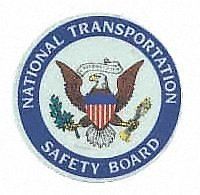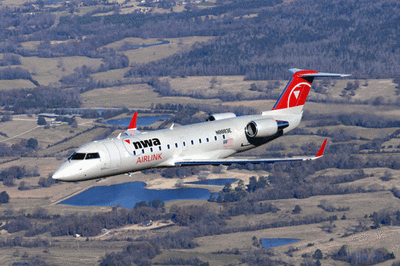CRJ-200 Slid Off Snowy Runway After Airport Closed
 The
National Transportation Safety Board today released the following
update on its investigation into the runway overrun of a Bombardier
CRJ-200 regional jet on April 12, 2007, about 12:43 am EDT, in
Traverse City, MI.
The
National Transportation Safety Board today released the following
update on its investigation into the runway overrun of a Bombardier
CRJ-200 regional jet on April 12, 2007, about 12:43 am EDT, in
Traverse City, MI.
As Aero-News reported, Flight
4712, operated by Pinnacle Airlines, overran the runway while
landing at Cherry Capital Airport in Traverse City. There were
no injuries among the 49 passengers (including three lap-held
infants) and three crewmembers, and the aircraft received
substantial damage.
The NTSB states the flight was cleared for an instrument landing
system (ILS) approach to runway 28 by Minneapolis Air Route Traffic
Control Center. The Traverse City control tower was closed at
10:00 pm per normal operations. Weather was reported as snowing.
Automatic weather observation data indicated at 12:30 am, the
visibility was one-half mile in snow, with indefinite ceiling and
vertical visibility of 200 feet.
Snow removal operations were in progress at the airport, and the
flight crew communicated directly with airport operations regarding
the runway conditions.
After landing, the airplane overran the departure end of runway
28, which is 6,501 feet long, with an additional 200 feet of
pavement. Initial examination indicates that the airplane exited
the paved surface onto a grassy snow-covered field, the nose gear
separated from the fuselage, and the airplane came to rest about
100 feet beyond the pavement. The passengers and crew exited the
airplane via the main cabin door.
A go-team was launched from NTSB Headquarters under the
direction of Investigator-in-Charge Bill English and specialists in
Operations, Human Performance, and Airworthiness.
Flight data and cockpit voice recorders were recovered from the
airplane and read out at the NTSB laboratory in Washington DC.
Initial audition of the recorders indicates both were in good
condition and include the accident flight. A cockpit voice recorder
group was formed and will produce a transcript of the
recording.
The Operations and Human Performance Group interviewed the
flight crew on April 13. The captain, a company check airman who
was piloting the aircraft, had a total time of about 5,600 hours,
with 4,390 flight hours in the CRJ-200. The first officer, who had
been hired by Pinnacle in January of 2007, had 2,500 total flight
hours, with 15 flight hours in the CRJ-200.
Additional interviews of airline personnel involved with the
flight and the crew were done on scene or scheduled for the near
future. Airport personnel working at the time of the accident, and
airport management personnel were also interviewed, and an Airport
Operations Group has been formed.

Further work remains in evaluating the recorder data, weather
information, airport field conditions and communication, and
performance of the airplane. An Aircraft Performance Group will be
formed, and specialists in Meteorology and Air Traffic Control are
also supporting the investigation. Parties to the investigation
include the Federal Aviation Administration, Pinnacle Airlines,
Airline Pilots Association, General Electric Aircraft Engines, and
the Northwest Regional Airport Commission. The Transportation
Safety Board of Canada has provided an Accredited Representative
and technical advisors from Bombardier Aerospace.
 ANN's Daily Aero-Linx (05.06.25)
ANN's Daily Aero-Linx (05.06.25) ANN's Daily Aero-Term (05.06.25): Ultrahigh Frequency (UHF)
ANN's Daily Aero-Term (05.06.25): Ultrahigh Frequency (UHF) ANN FAQ: Q&A 101
ANN FAQ: Q&A 101 Classic Aero-TV: Virtual Reality Painting--PPG Leverages Technology for Training
Classic Aero-TV: Virtual Reality Painting--PPG Leverages Technology for Training Airborne 05.02.25: Joby Crewed Milestone, Diamond Club, Canadian Pilot Insurance
Airborne 05.02.25: Joby Crewed Milestone, Diamond Club, Canadian Pilot Insurance




